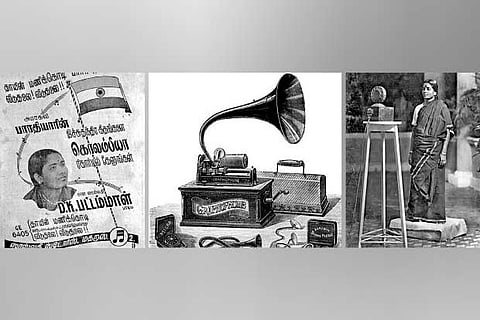

Chennai
Arts was expensive till medieval times and needed sponsors to support it. Especially performing arts. To train a musician in Carnatic or Hindustani would have taken a decade of support and only a rich man who could afford to pay and feed a team of trained musicians could listen to their music daily.
Musicians hence found refuge in Chettinaad and Tanjore district where sponsorship was easy to come by. Writer Kalki would mention how he would stand along with the villagers at the gate of a Mirasdar in Mayavaram to listen to the Carnatic songs being performed in the landlord’s family wedding.
But in 1877, there was no contraption to make music a mass media and the time was ripe for an invention that would democratise music. While other inventors had produced devices that could record sound, Edison’s phonograph (gramophone was a trademark name) in 1877 was the first to reproduce the recorded sound.
Edison’s intention was to market his Phonograph as a business dictation machine. Ironically, the concept of recorded music did not even cross the mind of the mastermind.
The first machine that mass produced music was invariably the gramophone. To many it was magic and they often discussed of a lilliputian orchestra living within the instrument. But even the gramophone was initially a status symbol. They were imported in India before 1900 by those who travelled abroad and displayed it at a prime location in their living rooms. Mutoscope Biograph Company established in Calcutta in 1901 introduced the gramophone to the common market.
In 1910, The gramophone recording industry embraced the musicians and vocalists of the Tamil stage. Since most records were made in Germany, the artists were asked to announce their names in English at the end of singing, to help the technicians label them properly. Observes have noted the most of the initial records had voices from the devadasi community.
It was a big boost for Indian recording industry when the raw materials for the records were changed from wax to lac — an insect secretion. At that time, India used to produce up to 75 per cent of the world’s lac and this led to record companies setting up shop in the country.
With sound not having incorporated in films at that time, recording companies had established Tamil drama music as some of their best-selling records and transformed stage singers and musicians into stars and household names. They also recorded entire dramas and sold them as sets. But when the Tamil talkie came in 1932, people expected the gramophone to fade away. But, it easily jumped that barricade. Since gramophone fans were also avid talkie watchers, film songs have been a heavily stressed on and it was common for a Tamil film to accommodate fifty or sixty song sequences.
For the producers there were twin advantages. Pre-release publicity and extra revenue. Since Madras Presidency was not electrified for most of its geographical area, a gramophone that did not depend on power took news and samples of the talkie to every nook and corner of the Presidency.
There were other linkages too. AV Meyyappans father Avichi Chettiar marketed records in Chettinaad which had the greatest concentration of gramophone players due to their international trade. AVM’s Saraswati Stores was the first to establish its own dramatic company for the production of drama record sets in July 1933. This was the stepping stone for AVM who moved on to films in the mid-1930s. When MK Thyagaraja Bhagavathar, the reigning monarch of the screen, refused to record his film songs for AVM’s Saraswathi Stores owing to disagreements on royalties, Meyyappan had another singer Thuraiyur Rajagopala Sarma sing the same songs with an in-house orchestra and released them. MKT scared out of his wits rushed to AVM for a compromise deal.
Even politicians understood the power of the gramophone. When KB Sundarambal was mourning the premature death of her husband Kittappa and kept away from public glare, Congress man Sathyamurthi persuaded her to come back and join the party. A gramophone record of her songs on one side and Sathyamurthi’s speech on the other, multiplied his fame.
The gramophone helped to create film songs as a new and distinct popular music genre, and held its sway till radio became a household contraption.
—The author is a historian
Visit news.dtnext.in to explore our interactive epaper!
Download the DT Next app for more exciting features!
Click here for iOS
Click here for Android